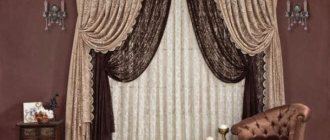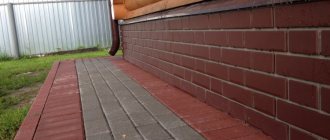Vadim
1294 0 0
Vadim November 10, 2018
Some consider old upholstered furniture to be a burden that needs to be thrown away, while others send it into exile. But there is a more rational option - do it yourself. Next, we will conduct a step-by-step analysis of the main stages of chair restoration, starting with the selection of materials and ending with putting the product into operation.
The decor of the updated chair can be matched to any style of the room.
Types of chairs
There are many different types of chairs, varying in level of comfort, cost, and methods of placement in space. The design is an “improved chair”, which has a soft back and seat covered with textiles, leather, faux leather, fur, and in some cases, armrests, a footrest, and a rocking mechanism.
The main classification looks like this:
- by purpose - for relaxation (interior), for work (office);
- according to design features - with a rigid frame, without a frame;
- at the place of installation - in the living room, in the garden or on the veranda, office (computer), gaming (game) rooms.
The design of the item itself is also different, there are:
- ordinary - installed on four legs, have a soft back, armrests, coffee stands, poufs, and other details that provide maximum comfort;
- chair-beds - designed for cramped rooms, significantly saving space. It is not recommended to constantly sleep on such furniture, but it is possible to place an unexpected guest who is staying overnight on it, and also to use it in a summer cottage;
- rocking chairs - made classic (on ski runners), with a pendulum mechanism (have a fixed base), spring (rattan papsan rocking chairs), as well as “Viennese chairs” (runners are connected in a closed circle);
- advertisers are especially comfortable, expensive models that can be fully reclined and have a footrest. Transformable manually or electrically. A ventilation system, mini-bar, vibration massage, etc. are sometimes built in here;
- hanging - it can be a hammock, an “egg”, a ball, a “cocoon”. Hanging is done on the ceiling, wall, stand, beam.
Frame models are made of natural wood, metal, plywood, chipboard, and plastic. Usually several materials are used at the same time. Frameless options are pillow bags filled with foam balls and synthetic fluff. There are also convertible, lightweight inflatable items.
How to re-tighten?
Reupholstering a chair with your own hands at home is always carried out according to a certain pattern.
Disassembly
Simple step-by-step instructions make it possible to independently disassemble the chair into individual components.
- The first step is to remove all removable elements, that is, covers and, possibly, armrests.
- Next, the chair is placed on its back and the legs are removed.
- By disassembling the fasteners connecting the back and the frame, you will be able to separate these parts. Usually, to do this, the screws are unscrewed with a screwdriver, and the nails are pulled out with a nail puller.
- The old staples are removed from the bottom, and then the bottom itself is dismantled.
- If the armrests are still in place, they can also be removed by unscrewing the screws.
- At the end, the remaining staples holding the fabric sheet are removed, and it is removed, but not thrown away. It is better to do this carefully and not create tears, since the old material may be needed to create a pattern for a new cover. Moreover, it is wise to immediately sign where the top and bottom of the structure were located.
- If the chair was soft, and the filling has already gone out of condition, then it will have to be changed, which means that the old one can be thrown away immediately. In the case when the foam rubber is in order, it can be left unchanged, or simply supplemented with a new layer.
- Before working with fabric, the frame is also cleaned of dust, and damaged fittings are replaced with new ones. Wooden elements can be sanded, repainted or varnished, and those that are not visible can simply be coated with a protective agent.
- In general, processing of visible wood elements is done using coarse sandpaper, which removes both the varnish and paint layers. Next, you can use another type of sandpaper - with fine grain, or even a grinding machine.
- After cleaning the wood from dusty residues with a soft cloth, you can immediately proceed to painting. To apply the coating evenly, you will need a brush, sponge or aerosol can - the choice depends on the features of the part, its size and personal preferences. It is better to apply the dye in two or even three layers and, after waiting for complete drying, use two or three layers of varnish.
Cutting fabric
When initially purchasing a fabric fabric, you need to ensure that this is done with a ten percent margin of length. You can cut out the cover using old upholstery, or using a new pattern drawn on the remains of wallpaper or sheets of paper of the required format. In the first case, the new material should be placed face down on the floor, and then all parts of the old cover should be placed on it. It is important not to forget about the shared thread. If the upholstery of the sofa is decorated with patterns, then it is necessary to lay out the components of the cover, taking this into account. The fibers of the material should always face down. It is convenient to apply the pattern to the fabric using a bar of soap or a special chalk. The contours are outlined taking into account allowances equal to five or seven centimeters.
When using a new pattern, you will have to cut out the parts taking into account the folds that arise. It will be convenient to fix the paper on the canvas with pins. You can sew the parts together either by hand or on a sewing machine. To decorate the edges, experts recommend using a hem stitch. When cutting fabric, we must not forget about cutting the filler, which is foam rubber and batting. Since the second material is used to fix the first, it will also need to be trimmed, using either an old cover or a new pattern. In this case, there is no need for wide allowances.
If leather is chosen for upholstering a chair, it is important to remember that a sewing machine needle is capable of sewing only thin samples of material, 1.5 millimeters thick. Before starting the main procedure, the blanks must be “tried on” to the product, secured together using clothespins or some other device that does not harm the skin. Only after making sure that the cutting is correct can you proceed to direct sewing.
Reupholstery and assembly
It’s not that difficult to reupholster a chair yourself without restoring the frame. In principle, you can even cover the furniture with a new coating without removing the old one - this is not particularly welcomed by experts, but it saves a lot of time and makes the chair more voluminous. However, in the basic version, the old cover is still changed along with the filler. The reupholstery must begin by sheathing the back. To do this, foam rubber is fixed on the inside, the corners of which, if necessary, are cut off to achieve a rounded shape, and batting is placed on top. Using a furniture stapler, the edges of the material are fixed to the back surface of the backrest, although some prefer to use regular glue for this. It is important to maintain a gap of several centimeters between the staples, and to even out the material itself, eliminating creases and wrinkles.
Features of do-it-yourself banners
Anyone who decides to remake an old chair into a more modern one is completely free to choose materials and the style of the future design. Before starting work, you should decide in which room the product will be placed and who will use it. For the nursery, “cheerful” colors are selected, but non-staining, natural fabrics. The kitchen uses materials that do not absorb liquids and odors. It is important that the updated item fits optimally into the existing interior. Depending on the design of the upholstered furniture and the accuracy of the craftsman, its repair will take from a couple of hours to several days.
Renewing ancient, rare items of historical value should be done very carefully; sometimes it is even worth entrusting such a task to specialists.
The benefits of making it yourself
It’s a big plus if the sofa has a high-quality base. Old pieces of furniture are much better quality than those that are produced now.
Replacing the upholstery will not take much time and effort.
Restoring furniture at home has several benefits.
- You reupholster the sofa with any material you like, and you can add picturesque elements to your liking.
- When performing work to replace the upholstery, you can repair the frame or spring unit if necessary.
- Outdated sofas, as a rule, are the strongest and best quality, prevailing in all properties over modern furniture.
- By doing this work yourself, you won’t spend a lot of money, but a new sofa or chair will cost much more.
- You don’t have to throw your favorite soft corner into a landfill because it has become unusable.
It’s worth deciding whether you will reupholster the sofa yourself, in which case the work will take more time, or trust the specialists, they will do it in a short period, perhaps at your home, without transporting it to a workshop.
Advantages and disadvantages
Hand-made reupholstery of home and office furniture has many advantages:
- significant budget savings - it’s easier to buy a couple of meters of textiles and a piece of foam rubber than a whole new chair;
- creative process - independently remaking even the simplest, nondescript chair will help you feel like a real master;
- the possibility of updating the interior - a freshly redesigned chair will be designed exactly as its owner intended;
- A quality restored product will last for many years.
There are also several negative points:
- the product will be very different from the store one - this matters if you want to create a specific model, but the skills are not yet enough;
- the labor-intensive process - if the chair is badly damaged, not only the fabric is replaced, but also the “filling” - foam rubber, springs, while completely disassembling it;
- For work you will need some tools that are not available in every home;
- You will need to organize a workspace, which will then have to be thoroughly cleaned, since the restoration process is quite dusty.
Fabric selection
The modern variety of fabrics and non-woven materials will allow you to choose the best option for decorating almost any design. Experts divide all textiles into nine types - from zero to eight, where the zero group includes the thinnest, cheapest, and quickly wiped, and the eighth group includes the most expensive, durable, wear-resistant. They are made from natural, artificial, and mixed fibers, differing in the way the fabric is woven. Non-woven materials are also used for upholstery.
The ideal upholstery material should be:
- wear-resistant;
- durable;
- durable;
- colorfast;
- hydrophobic;
- smooth;
- soft.
The most popular options:
- tapestry;
- flock;
- chenille;
- jacquard;
- scotchguard;
- thermojacquard;
- velours;
- matting;
- boucle;
- leatherette;
- microfiber;
- leather.
Some natural fabrics exhibit significant (more than 10%) shrinkage, which must always be taken into account.
Selection of materials
Before you start working at home, you need to select materials for upholstery and soft substrate. You can use what you have on hand or purchase products from specialized furniture stores.
Particular attention should be paid to the structure and density of the fabric
For soft substrate
For a soft backing, you can use foam rubber. This is the most common and cheapest material. Its more expensive and high-quality analogue is padding polyester. However, experts recommend using natural options, for example:
- copra;
- batting;
- horsehair;
- burlap.
Foam rubberSintepon Copra
For upholstery
The fabric for upholstering the chair should be dense and hold its shape well.
Another important requirement is wear resistance. The material should be easy to clean from contamination
| Option | Peculiarities | Advantages | Flaws |
| Leather | Natural, environmentally friendly material that does not cause allergies. Available in a variety of colors | It lends itself well to mechanical stress, which is very convenient when re-upholstering. | May crack or warp due to sudden temperature changes. Cheap options look similar to leatherette |
| Jacquard | Consists of multi-colored threads or monochrome fibers. Has a textured surface | Long service life, durability | Heavy fabric, quite difficult to care for |
| Flock | Material with a small pile, the composition includes polyester and cotton. The base is covered with a thin layer of glue | Wear-resistant, easy-care fabric | High price |
| Velvet | Smooth fabric with a small pile, practically does not wrinkle | The fabric is easy to work with and upholstering the chair is very simple. Spectacular design | Quickly begins to shine and fade if not properly cared for. |
| Chenille | Between the spiral of two threads there is a pile. Looks like velor | Inexpensive, resistant to external influences | It is difficult to remove old, ingrained dirt |
| Tapestry | Has a dense rough texture, includes 3 layers of threads | Easy to wash and remove stains. Durable and comes in a variety of patterns | Wears out quickly, fades in case of prolonged exposure to the sun |
The list of recommended materials also includes faux leather. It has a smooth, pleasant to the touch structure. Its main advantage is its spectacular appearance. Disadvantages - rapid wear.
LeatherJacquardFlockVelvet
How to take measurements correctly and calculate the amount of fabric
The easiest way to find out how much textile and foam rubber you will need for upholstery is to disassemble the item itself, remove the covering from it, and trace it on a new piece of fabric. The disadvantage of this method is that during use the fabric could stretch greatly. They measure more accurately this way: take measurements directly from the chair itself, using a tape measure. Here the width, length, height of the soft part are taken into account, and 10-15% is added to the results obtained for allowances. For a standard “home” chair you will need a piece of fabric measuring approximately 350 by 140 cm, for an office chair – 170 by 140 cm.
If you plan to decorate the armchair with a valance or voluminous pleated elements, 40-70% more material will be required. When a large pattern is applied to the textile, which will have to be combined here and there, it is also taken with a reserve.
Step-by-step instruction
Work should be carried out strictly in a certain sequence in order to correctly assemble the chair after restoration.
- Unfasten the fabric from the bottom of the chair. We don’t throw away the removed fabric, but use it to make a pattern from new fabric. We remove the old foam upholstery by carefully unbending the staples. Using sheets of removed old foam rubber, we cut out blanks for new upholstery.
- Pattern of new elements from fabric, applying old ones.
IMPORTANT! When cutting out new elements, you should allow allowances of a couple of centimeters, because you cannot immediately predict how the fabric will lie.
- We fix the foam blanks on a suitable wooden surface. The resulting protrusions should be removed by simply cutting off the excess foam. We lay a padding polyester layer on top of the foam rubber. We fasten both materials using a furniture stapler to the chair frame.
- Fastening the fabric, the last stage in the restoration of your favorite chair. It starts with leveling and then checking the tension of the web. An important point is the correct location of the cut pieces. To avoid distortions when fixing, you should start from the middle of the workpieces, and then tighten and fasten each corner sequentially.
Covering a wooden surface with fabric is used for old furniture that did not have a fabric covering and is very similar to upholstery, only without replacing the foam rubber.
Therefore, the process is carried out in the same sequence. You just need to take the correct measurements for the patterns.
Necessary tools and materials for restoration work
To successfully repair a chair you will need:
- furniture stapler with a set of staples - for fastening fabric;
- foam rubber, batting - as padding;
- pry bar - for removing old staples;
- screwdriver, pliers - for disassembling the product;
- hammer, adjustable wrench - to assemble the structure;
- sewing machine;
- pins;
- fabric chalk;
- sharp scissors;
- stain, varnish;
- sandpaper or sander - to clean wooden parts from old varnish.
Required materials and tools
First you need to select a set of tools and materials.
You can use a standard set of tools, and a set of brushes and paints for a painter. Unavailable tools are purchased according to the recommendations of the master, so as not to damage the parts during work. Pure wood furniture is sensitive to floors and can dry out.
First you need to select a set of tools and materials or ask a specialist to select the necessary
Required materials and tools:
- chisel, spatula;
- hammer, screwdriver;
- stationery knife, wood glue;
- set of brushes, roller;
- acrylic paints, water-repellent varnish;
- sanding machine, foam rubber;
- stapler, sandpaper, new springs;
- screwdriver, awl, large needles with silk threads.
Step-by-step instructions for reupholstering a chair with your own hands
Reupholstery of upholstered furniture begins with complete disassembly of the product and inspection of existing damage. Afterwards, the soft filler and fabric are measured, cut, and secured. The structure is assembled and decorated at your own discretion. Before starting work, it is recommended to read the instructions on how to disassemble and upholster the chair step by step.
Disassembly
Most old chairs are made of wood or from materials such as chipboard, and the fastenings are made on a tongue-and-groove basis, using steel corners, self-tapping screws, and wood glue. To disassemble the product, place it on its back, unscrew the legs and armrests. Next, disassemble the bottom, removing staples and other fasteners from it. Then the upholstery is removed as carefully as possible, which needs to be detached without damaging it, since it will be needed to cut out a new cover.
When disassembling, it is important to remember where everything was attached, otherwise there will be difficulties with assembly.
Assessment, damage correction
When the product is completely disassembled, all parts are disconnected, the fabric is removed, a thorough examination is carried out for cracks, chips, and joint defects. If such are found, they are dealt with first - broken parts are replaced with similar, homemade ones, loose connections are replaced. You also need to evaluate the condition of the padding - when the soft surface has serious unevenness, the material is torn or crumbles, it is removed, and a new one is nailed into the vacant space with staples. To make the edges look aesthetically pleasing, the corners of the foam rubber are cut off and something like a chamfer is made along the edge.
Cutting and attaching new fabric
The chair must be covered with properly cut material. Its quantity is calculated based on the perimeter of the back, seat, height of the filler, a few centimeters of hem on the back side of the structure. After measuring the product, a piece of fabric of the required size is selected. The standard fabric width is 140-150 cm, the length depends on the size of the chair, the height of the backrest, and the number of parts. If the structure is folding, a small allowance for unfolding is also necessary.
The standard set of elements is something like this:
- the front part of the backrest and seat are sometimes made in the form of a single piece;
- back surface of the back;
- armrests – internal, external parts;
- a narrow strip along the bottom;
- Some designs require the presence of side parts for armrests and backrest.
All fabric parts are pinned together, tried on a chair, and if necessary, the patterns are slightly adjusted. Next, the elements are sewn down on a sewing machine, the finished cover is put on the chair, pulled tightly, and secured with staples in inconspicuous places. If the work is done manually, use a “sail” or “denim” seam. If you have an overlocker, all seams are sewn over it - this will make the upholstery denser and prevent the joints from unraveling.
If fabric with pile is used, its direction on different parts of the structure must be monitored, since the multidirectionality is too visible in the light.
Assembly, decor of the updated product
The most difficult thing to assemble is a folding chair, since you will have to carefully fasten the moving mechanisms without losing the bolts or putting the part upside down. If the mechanism creaks or jams, lubricate it with machine oil. At the same stage, wooden parts are processed - they are sanded, tinted with stain, and varnished. The legs and wooden armrests are screwed in at the very end.
Pillows are most often used as decoration. They are sewn from the same fabric as the upholstery, made contrasting, decorated with embroidery and appliqué. If a product has many wooden parts, they are hand-painted and patinated.
How I reupholstered the chair
Three and a half years ago my chair broke. My beloved husband thought and thought and bought me a new one. Expensive! Great! Soft... Made from eco-leather (apparently young dermantine leather). With a rocking chair function and other bells and whistles.
For about a year and a half, the chair delighted us with its rugged office look, helped me rock my newborn daughter, and generally behaved perfectly.
The armrests were the first to fall off. Right one first. Then left. The left one fell off along with a piece of internal reinforcement. I sighed and discovered that without armrests it was even more comfortable - you could sit with your feet up in the chair.
Then it turned out that eco-leather is really eco. Well, from those materials that do not pollute our nature, turning into water, gas and biomass in three to five years. The upholstery of the chair began to simply fall apart, not at the seams, the seams were just intact - the eco-leather itself was worn to holes. Once the casing is damaged, foam rubber begins to attach to it. It crumbled, fell to the floor, cats and children took it away... In general, three years after the purchase, the chair looked like this:
No. The dog didn’t eat it, we don’t have a dog. The cats didn't bother him either. They just sat on it.
For about a month I tried to sew up the unraveling fabric, but the threads ripped through the decayed lining without any effort. In the end, the husband could not stand it: “Honey,” he said, “Why don’t you finally fix your chair?”
I was surprised. He usually does furniture and other renovation work for us. But, on the other hand, he just had a crazy problem at work, and if he asks to fix it, it means it’s necessary. “It won’t be fast,” I replied. And she got to work. Taking my time, so as not to burden the family budget planned for six months in advance, I purchased materials and tools. By the time of the big New Year's weekend, I had in my hands a furniture stapler, staples for it, a piece of tapestry and a hefty plate of foam rubber (alas, it was not sold in small pieces).
The husband's employers do not respect holidays, so shortly after the New Year he left to hunt for mammoth. And I started fixing the chair. Together with my son, they unscrewed the chair into pieces, put the nails and rubber pads-circles on my table, then my son went to play with his sister, and I took the skin off the chair. I was amazed at how well it was made (a strong base made of bent plywood, foam rubber of varying hardness, everything was glued, pulled to shape, the perfect seams looked amazing against the background of the rotten cladding). True, the broken fittings for the armrests could no longer be repaired, and I couldn’t think of anything to replace it with either, so I decided to leave the chair without them.
I took off the “skin”, took it apart into patterns, and wrote down how everything was assembled. I cut out new details from the tapestry. Replaced the top layer of foam on the seat and back. And she sat down to sew. By this time, inspiration had already taken over me completely, which meant that for some time I was lost to the world. I prepared food for the whole day in advance.
My husband came home from work and discovered that in the living room (also known as an office, dining room and main living room) on all surfaces there were: pieces of a chair, pieces of chair upholstery in duplicate (old and new), scraps of foam rubber, a construction set of 650 parts (the children scattered ), a few toys and two cats. The children wisely evacuated to the bedroom (as it turned out later, they took about a third of the construction set with them. On to their parents’ bed. And stuffed them under the blanket). Above all this chaos towered a table on which a sewing machine chirped victoriously and I, lost to the world, sat. My husband made an astonished face and wanted to ask something, but he saw inspiration in my eyes, understood everything and quietly retreated to the kitchen to look for dinner. There he was surprised again, because there was dinner, the children carefully left dad some food.
Late in the evening the skin was finished, the mess was cleared up, the pieces of the chair and the skin were neatly folded in the corner.
In the morning, my husband went to work, and my son and I began putting new upholstery on the chair. We put it on, pulled it on, our son shot with a furniture stapler, our daughter got under our feet, everyone was happy. By evening everything was finished, all that was left was to assemble it. We planned to assemble the chair in the morning.
However, not all so simple! It was a day off. The children get up earlier than us on weekends, have breakfast and play. When I got up and decided to check if I was ready to assemble the chair, it turned out that the fasteners had disappeared! More precisely, the bolts were in place, but the hard rubber gaskets were not. To the question “Where?!” the son replied: “Uh... My sister was playing with them, I took them and put them...” He didn’t remember where he put them. I started searching. Waking up dad joined. As a result, before breakfast we managed to: sort through all the things in two cabinets with small things, on my table, on my windowsill and in two drawers with toys, at the same time separating Legos from large toys (the children constantly mix them up and then cannot find them). The gaskets were found in the very middle of the drawers - one in each. My husband expressed everything he thought about this start to the weekend - and we were finally able to have a bite to eat.
Then we all assembled the chair together into a single organism, I hemmed the backdrop, covering the traces of assembly - and the chair was ready.
This is how it turned out:
The husband got into it, sat and said: “Why did you suddenly decide to pull it over?” - “Well, you yourself said six months ago: fix it!” - “Well, actually, I thought that you would just sew a cover or a cushion for the seat so that the guts would not be visible... I didn’t think about global restructuring... But I like it better, yes...”
The nuances of restoring chairs with a spring mechanism
When upholstered furniture contains spring blocks, they can also “fail” over time. The springs are straightened with pliers, and the felt lining under them is changed if the latter is severely damaged. Sometimes it is necessary to tie and shrink the block itself - for this they use jute twine and belts. If there is a lot of damage, the spring structure is removed completely, replaced with several layers of foam rubber or a more modern design, where each spring is in a separate durable case.
Office computer chair reupholstery
In order to save the budget spent on updating the office environment, computer chairs are also restored by hand. If the frame is completely intact, only re-upholstery is required, which gives the structure an aesthetic appearance. Since the chair is used many hours a day, the most wear-resistant, durable fabrics, as well as genuine leather, are selected for upholstery. Leatherette and thin textiles will become unusable in a matter of months.
Measurements are taken separately from the back and seat, taking into account their thickness, allowances for turning and seams. If the filler is “leaky”, additional foam rubber is purchased. The product is disassembled using a screwdriver, the seat, back, and armrests are disconnected. In the process, it is important not to lose all the screws - it is better to put them in a box. Next, the upholstery is separated, and new foam rubber is attached in its place with construction staples. Afterwards the fabric is stretched - it is important that folds do not form on the surface. Now the chair is going back together.
Video: DIY furniture repair. Restoration of chairs.
If the old chair has already lost its original appearance, but you don’t want to throw it away, you can try to reupholster it. This procedure is not particularly complicated, and therefore can be successfully performed independently at home.
How to sew chair covers
To prevent the furniture upholstery from being wiped out or damaged by children and pets, a cover is sewn on it. It is advisable that within the same room all objects are decorated with the same material - this way the decor will not be disjointed. Fabrics used are cotton, velor, as well as flock, chenille, and microfiber.
Design solutions for capes are very different - they are country and loft, Provence and shabby chic, high-tech and baroque. Usually the cover completely covers the product, reaching the floor. Parts List:
- back – front, back, side;
- seat – upper, front part;
- armrests – two side, two end parts.
The patterns are traced on the fabric with allowances for a loose fit and seams, one or two cm. The parts are sewn on the wrong side, the cover is turned inside out and tried on. If the model provides for it, a valance skirt is sewn to the bottom. The latter is made multi-layered, lace, contrasting (the color matches the sides of the back and armrests), it will require a lot of fabric.
The cover is usually made from one or two shades of textile; it is not recommended to use more than three colors.
Preparation
At the preparatory stage of reupholstering an old chair, no special actions are required. You just need to choose the right fabric with additional impregnation against dirt and wear, and also prepare all the necessary tools. It is important to immediately understand what the end result will look like, and therefore buy the materials yourself rather than order them on the Internet. It should be remembered that an overly old chair cannot be restored at home, and it is better to leave this task to a specialist. Otherwise, the seat or legs may fall apart, and the furniture will have to be thrown away. Professional craftsmen also recommend photographing the chair from different sides in order to assemble it without any problems in the future.











